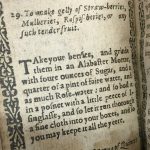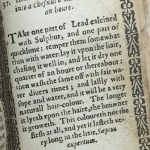Written by Louise Cowan, Trainee Liaison Librarian
Originally published in 1602, ‘Delightes for Ladies’ by Sir Hugh Plat is one of the earliest cookery and
household recipe books produced in England. It contains a fascinating array of recipes, instructions and advice on everything from making almond butter and preserving roast beef to creating candles for ladies tables and dying hair a lovely chestnut colour.
The little book was a perfect companion for the wealthy Elizabethan housewife who owned her own Still Room; a place in the house, usually linked to kitchen and garden, where the ‘still’ was kept for “the distillation of perfumes and cordials,” (Oxford Dictionaries), it was also where food was preserved and stored and where medicines, cosmetics and alcohol could be made.
The author began writing shortly after graduating from Cambridge University in 1572 (Plat, 1955), publishing a number of books which similarly offered advice and new ideas on the topics of agriculture, food preservation and gardening. Plat’s ‘Delightes for Ladies’ however, was one of his most popular works, having at least thirteen editions produced before the middle of the seventeenth century (Plat, 1955). The work was more recently reprinted in 1948 amidst post-war austerity by G.E. & K.R. Fussell with the hope that “we may be able to use some of the simpler and less recondite recipes for the zest they may add to our plain, wholesome diet.”
Although ‘Delightes for Ladies’ was often bound together with another similar work, ‘A Closet for Ladies and Gentlewomen, or the Art of preserving, conserving, and candying,’ believed by most to be by the same author, our edition contains only the ‘Delightes’. The book itself features a poetical preface and is divided into four sections with the table of contents acting as an index. The sections cover, ‘The Art of Preserving, conserving, candying, &c’; ‘Secrets in Distillation’; ‘Cookery and Huswifery’ and ‘Sweet Powders, Oyntments, Beauties, &c.’ Below are some of my favourite pieces of advice from the book:
A 29. To make gelly of Strawberries, Muberries, Raspisberries, or any such tender fruite.
C.40 How to hang your candles in the aire without candlestick.
D.20 How to take away any pimple from the face.
D. 37 How to colour the head or beard into a chestnut colour in halfe an houre.
It is probably best not to try some of these at home…
Sources
Plat, Hugh (1628) Delightes for Ladies to Adorne their Persons, Tables, Closets, and Distilatories with Beauties, Banquets, Perfumes and Water. Read Practice, Censure. London: H.L and R.Y. [Stenton B/G27 – available upon request]
Plat, Hugh (1955) Delightes for Ladies. Reprint of Delightes for Ladies by Sir Hugh Plat, 1609. Introductions by Fussell, G.E. and Fussell, K.R. (ed). London: Crosby Lockwood and Son LTD. [MERL LIBRARY NUPTO NH10 – available upon request]
Oxford Dictionaries (2016) http://www.oxforddictionaries.com/definition/english/still-room OUP.








Re Sir Hugh Plat’s Delights for Ladies.
You give 1602 as the first edition. It is possible that there was an edition in 1600 when I believe it was entered into the records of the Stationers Company. I know of an incomplete copy in private hands which may be a 1600 edition.
Much of the book is derived from notes kept by Plat which are in the British Library. There are no notes relating to the work often bound with this book-A Closet for Ladies and Gentlewomen – and I think it unlikely that work is by Plat. The quality of the recipes in Delights for Ladies varies- the preserving ones are much better than those for cookery. This to some extent is because Plat was much more interested in food preservation but it is also a reflection of the fact that most of the cookery recipes are not by Plat- they are from a document he acquired. There is evidence that this manuscript was written by a priest sometime in the reign of Queen Mary. For a full discussion of Plat’s authorship of the book see chapter 5 of, Malcolm Thick, Sir Hugh Plat: the search for useful knowledge in Early Modern London, Prospect Books, Totnes, 2010.
Thank you for your comment Malcolm, it is always interesting to learn more about items in our collection from researchers who have much deeper insights. The origins of some of Plat’s recipes is particularly fascinating – thank you for letting us know where to find out more.
1602 as publication date came from our 1955 facsimile but we agree it could have been published earlier, one of our UMASCS Librarians recently found reference to two editions printed in [1600?] (http://estc.bl.uk/S125836 and http://estc.bl.uk/S125836 ). Presumably these editions weren’t known about when the 1955 facsimile was published.